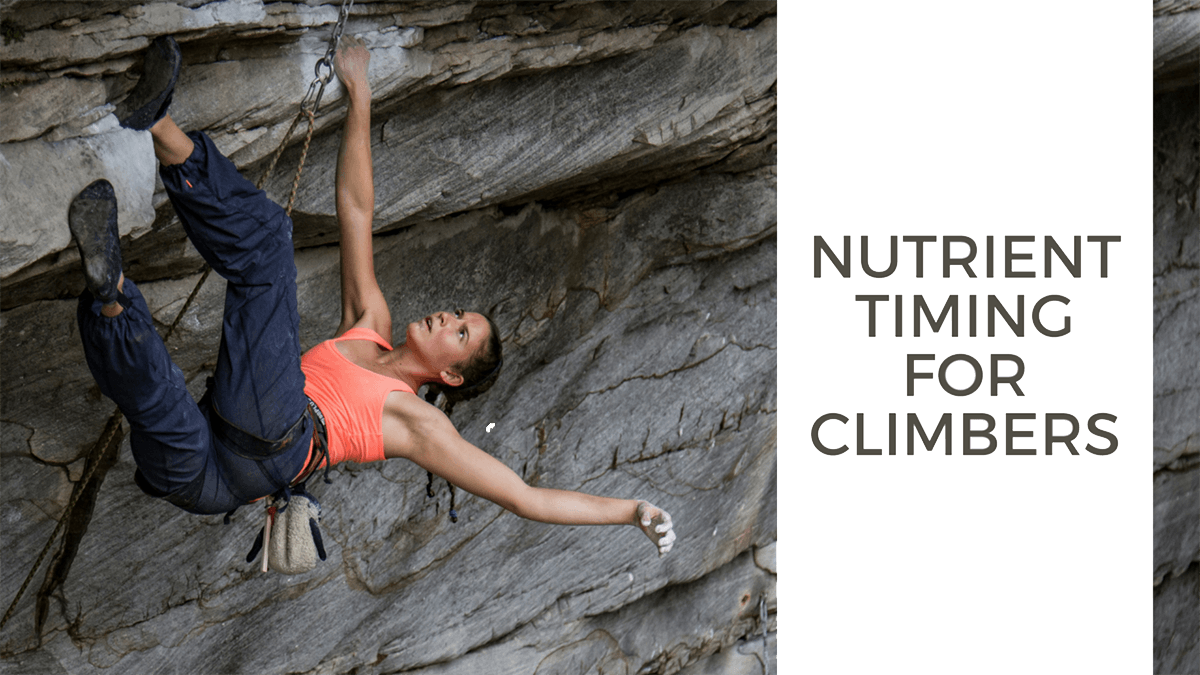Nutrient Timing for Climbers

The nutrition world can be a confusing one, especially when it comes to athletes. It seems everybody has their own philosophy; every sports professional touting the superiority of his or her diet. So where do climbers fit in? We’re not going to eat like triathletes, but what about weight lifters or gymnasts
Climbing is a primarily “Type II” muscle fiber sport, relying on quick and powerful movements that challenge our bodies for very brief amounts of time (compared to say, a half marathon). Even if we go to the gym for a few hours, or spend all day at the crag, the minutes spent climbing add up slowly, while taxing our muscles pretty rapidly. I do want to point out that big wall or multi-pitch climbing can be a different animal altogether, and the nutrition should reflect that. But for our conversation now, let’s focus on sports climbing, bouldering, and sure, we can throw in a two or three-pitch route too.

All this is important to clarify because it changes what foods to focus on before, during, or after a climbing session. With such a short “attempt” time on the wall, our physiology will rely almost exclusively on carbohydrates to climb. There is simply not enough time in the attempt to cross over to using fat as a fuel. However, this doesn’t mean “carbo-loading” like a runner is an answer either, for the same reasons that we would consume our energy climbing before we would drain our carbohydrate stores.
So I find it most helpful to think about fueling our climbing like “topping off the tank,” and then focusing on recovery nutrition between sessions. No one wants to feel heavy when they climb, so picking quality sources that get you bang for your buck is essential.

BEFORE: Focus on easily digestible sources of carbohydrates one to four hours before climbing. If it’s closer to the four-hour mark, it can be a bigger meal, while decreasing the amount the nearer you get towards the one-hour mark. If you get in a pinch under that one-hour mark, go for liquid sources like a sports drink or a smoothie instead. Limit large amounts of protein and fat, or foods high in fiber, which can steal precious energy for digestion.
Examples: Bean burrito, PB&J, Clifbar, Larabar, banana and nut butter, pretzels, carrots and hummus, orange.
DURING: Unless you’re going at it hard in the gym, at a competition, or at the crag for hours, it is not needed. If you find yourself feeling lightheaded, grab a sports drink. If you need to refuel, fast- and easily-digestible carbs are even more crucial.
Examples: Dried dates, Larabar, orange juice, Gu Energy Gel, banana, a sports drink with carbohydrates and calories.
AFTER: Focus on getting quality sources of protein and carbohydrates within one hour to hasten recovery. A good source of fat is better here than beforehand. Timing a meal after climbing can be a good way to make sure your body has access to all it may need, but a good snack to get you through the next meal time can be fine, too.
Examples: Salmon with roasted broccoli and brown rice, chicken and baked sweet potato with grapes, two eggs with one piece of avocado toast, one serving of protein powder with water or almond milk, chocolate milk, Clifbar.
Work with your body’s physiology as a climber by fueling it with the proper foods at the proper time, and you’ll find your energy and recovery ability will clear the way for new sends and new goals.
Check our next blog to learn more Climbing Nutrition
Chauncey Carroll, BS, CPT, LPSN




